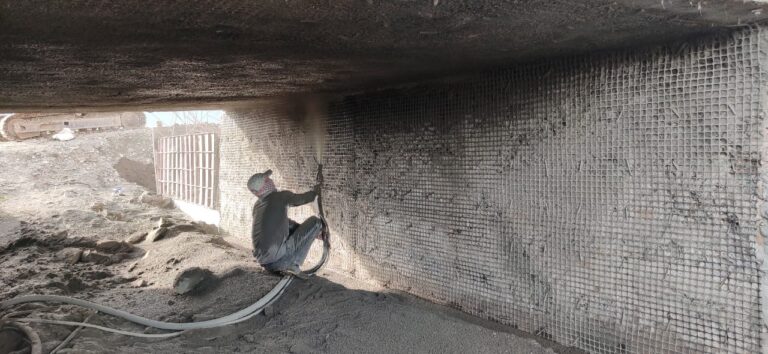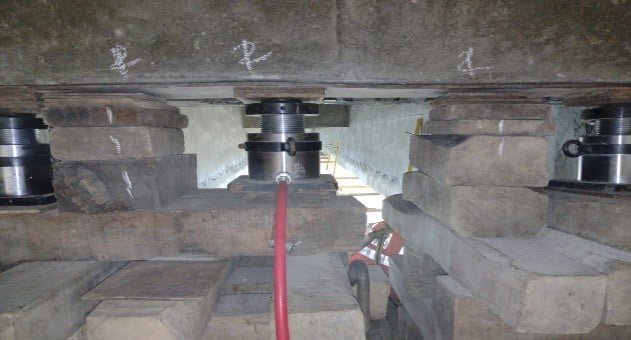Rehabilitation of an RCC Bridge
Rehabilitation of an RCC Bridge


As part of the four-laning of NH-161 from Kandi to Ramsanpalli in Telangana, the major bridge at km 8+541 was identified as a key structure requiring significant rehabilitation. The bridge, a vital transport link, spans 330 meters and consists of 12 spans each measuring 25.8m with a carriageway width of 8.4m. The sub-structure consists of RCC piers, while the super structure features RCC T-girder with deck slabs.
We conducted extensive Non-Destructive Testing (NDT) and structural inspections revealed performance and safety concerns including damage to existing bearings and expansion joints, distress, spalling, reinforcement corrosion, honey combs, and cracks in several T-girders.
Considering these challenges, the NHAI opted for a retention and rehabilitation strategy to extend the life of the existing structure.
Our Approach: A Comprehensive Rehabilitation Strategy
We designed a comprehensive rehabilitation approach to address challenges identified during the NDT assessment:
- Corrosion Protection: Exposed steel and corroded reinforcements were treated with corrosion inhibitors. This treatment was aimed to halt the progression of corrosion and extend the lifespan of the reinforcement.
- Crack Sealing and Grouting: We sealed the cracks in T-girders with high-strength, low-viscosity grout, ensuring thorough penetration and bonding. This process restored the structural integrity of the girders by re-establishing continuity and preventing further deterioration.
- Honeycomb Repair: Honeycombed concrete sections were carefully cleaned, filled, and restored using shotcreting and patch repair techniques to reinstate strength and appearance.
- Shotcreting Process: Large areas of deteriorated concrete were rehabilitated using high-velocity shotcrete. This process created a dense, durable overlay, improving protection against environmental exposure.
- Bearing Replacement: Damaged bearings were replaced with high-quality neoprene bearings. These elastomeric bearings are known for their durability and ability to accommodate movements and rotations. This involved lifting the superstructure, removing old bearings, and installing new Neoprene bearings to ensure flexibility and proper load transfer.
- Expansion Joint Replacement: The existing damaged expansion joints were replaced with new joints. This involved removing the deteriorated joints, preparing the surfaces, and installing new expansion joints that accommodate thermal expansion and contraction, as well as vehicular movements. The new joints were designed to provide a watertight sealing — preventing water and dust ingress and subsequent damage to the underlying structure.
Execution and Quality Control
The rehabilitation was planned and executed in stages to ensure minimal disruption to ongoing traffic. A dedicated safety plan was implemented, including barricading, clear signage, and worker safety measures.
Throughout the rehabilitation process, strict quality assurance and control protocols were followed at every stage. This included:
- Continuous monitoring and testing of materials.
- Ensuring compliance with relevant standards and specifications.
- Regular inspections to verify the effectiveness of the repairs and to ensure that the rehabilitation work met the desired performance criteria.
Outcome: Restoring Vital Highway Infrastructure
The rehabilitation process was successfully executed, restoring both structural and functional performance of the bridge. Subsequent NDT evaluations confirmed the successful completion of the bridge rehabilitation work. The restored bridge now provides a safer and more reliable transportation route, significantly contributing to the infrastructure development of the region.
This project illustrates the effectiveness of integrated repair and rehabilitation strategies in extending the service life of critical highway infrastructure. Through advanced techniques such as epoxy grouting, shotcreting process, and bearing replacement, the bridge was restored to optimal condition with minimal disruption to daily operations.
The outcome demonstrates our expertise as RCC repair contractors and ability to deliver high-quality, durable, and cost-effective solutions for large-scale RCC bridge restoration projects.


